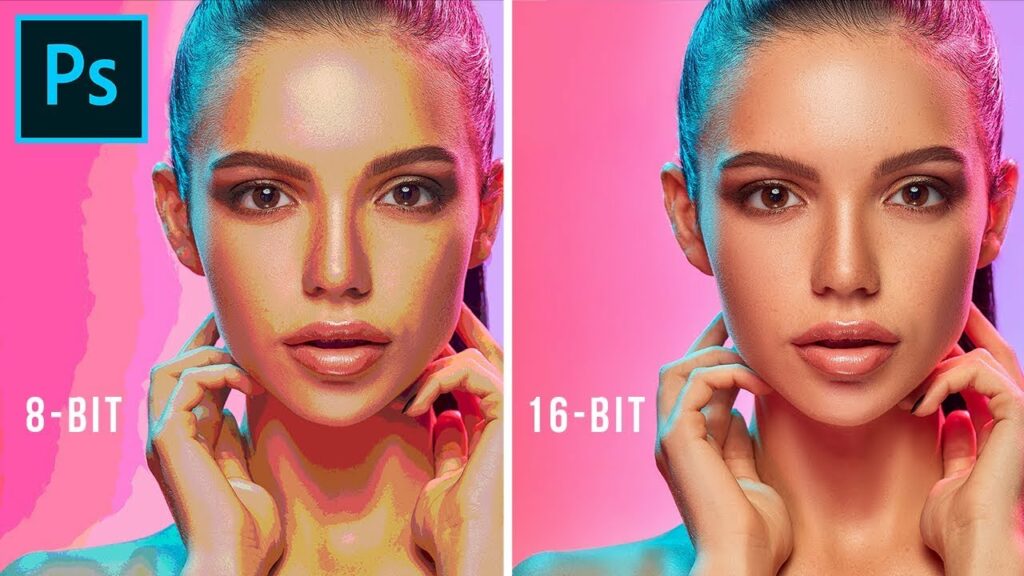Unveiling Precision: The Profound Benefits of Working with 16-Bit Images in Photoshop

Introduction:
In the realm of digital imaging, where precision and detail are paramount, the choice of bit depth plays a pivotal role in determining the quality and flexibility of your creative endeavors. While 8-bit images have long been a standard, the transition to 16-bit images in Adobe Photoshop brings forth a realm of benefits that elevate the level of detail, color accuracy, and post-processing capabilities. This extensive guide aims to unravel the myriad advantages of working with 16-bit images, exploring the technical nuances, and showcasing the transformative impact on image quality for photographers, graphic designers, and digital artists.
Understanding Bit Depth in Digital Imaging:
Bit depth refers to the number of bits used to represent each pixel in an image. In the context of digital imaging, bit depth directly influences the range of colors and tones that can be captured and displayed. While 8-bit images have been the standard for many years, the transition to 16-bit introduces a level of nuance and detail that significantly enhances the quality of digital content.
- 8-Bit vs. 16-Bit: The Color Spectrum:
- An 8-bit image can represent 256 levels of intensity for each color channel (red, green, and blue), resulting in a total of 16.8 million possible colors. In contrast, a 16-bit image can represent 65,536 levels per channel, leading to an astronomical increase in the potential color spectrum.
- Higher Precision for Gradients and Transitions:
- The higher bit depth in 16-bit images provides smoother transitions between tones and colors. This is especially noticeable in gradients, skies, and subtle color variations, where 16-bit depth prevents banding and posterization that may occur in 8-bit images.
- Dynamic Range and Shadow Detail:
- 16-bit images excel in capturing a broader dynamic range, especially in the shadows. This results in more nuanced details in dark areas, reducing the risk of losing information in high-contrast scenes.
Benefits for Photographers:
For photographers seeking to capture and convey the essence of their subjects, working with 16-bit images in Photoshop offers a wealth of advantages that contribute to the preservation of detail, color accuracy, and artistic vision.
- Retaining Highlight and Shadow Detail:
- In high-contrast scenes, 16-bit images excel in preserving both highlight and shadow detail. This is particularly crucial for landscape photographers capturing scenes with varying intensities of light.
- Reduced Color Banding:
- When editing images with subtle color gradations, the higher bit depth significantly reduces the risk of color banding, ensuring a smoother transition between hues and enhancing the overall visual appeal of the photograph.
- Enhanced Post-Processing Flexibility:
- The increased bit depth provides photographers with greater flexibility during post-processing. Adjustments, such as exposure and color grading, can be made with more precision, minimizing the risk of introducing artifacts and maintaining image integrity.
Advantages for Graphic Designers:
Graphic designers working on intricate visual projects find that 16-bit images in Photoshop offer a superior canvas for realizing their creative vision, providing a heightened level of control over color and detail.
- Vibrant Color Accuracy:
- Design projects often demand precise color representation. Working with 16-bit images ensures that colors are accurately conveyed, offering designers a broader and more nuanced palette to work with.
- Smooth Color Transitions in Gradients:
- Graphic designers dealing with gradients, whether in backgrounds or illustrations, benefit from the smooth color transitions facilitated by 16-bit images. This minimizes the risk of visible banding and results in a more polished and professional final product.
- Detailed Texture Rendering:
- The increased bit depth is particularly advantageous for projects requiring detailed texture rendering. Whether designing digital textures, illustrations, or 3D models, 16-bit images allow for a finer representation of surface details.
Empowering Digital Artists:
For digital artists immersed in the realm of creating visually stunning and conceptually rich artworks, the advantages of working with 16-bit images in Photoshop extend into the realms of texture, lighting, and the nuanced expression of artistic intent.
- Subtle Light and Shadow Variation:
- In digital art, the interplay of light and shadow is integral to conveying depth and mood. 16-bit images enable digital artists to explore subtle variations in lighting, ensuring that the nuances of their artistic vision are faithfully realized.
- Texture Richness and Detail:
- Digital paintings often rely on intricate textures to add depth and character to the artwork. The increased bit depth of 16-bit images allows artists to incorporate detailed textures, preserving the richness and subtlety of these elements.
- Reduced Artifacting in Complex Artworks:
- Complex digital artworks, especially those with intricate details and multiple layers, can sometimes suffer from artifacting in 8-bit mode. Working in 16-bit mitigates these issues, allowing artists to maintain the integrity of their creations.
Workflow Considerations in Photoshop:
While the benefits of 16-bit images are substantial, there are workflow considerations to keep in mind, including file sizes, processing speed, and compatibility with certain tools and filters in Photoshop.
- Larger File Sizes:
- 16-bit images inherently have larger file sizes compared to their 8-bit counterparts due to the increased data precision. This may impact storage requirements and file transfer times, especially for large projects.
- Processing Speed Considerations:
- Working with 16-bit images can be more computationally intensive, affecting processing speed, especially on older hardware. Consider the capabilities of your system and balance the benefits of 16-bit against potential workflow slowdowns.
- Compatibility with Filters and Plugins:
- Some Photoshop filters and third-party plugins may have limited compatibility with 16-bit images. Before embarking on a project, it’s essential to ensure that the chosen tools are compatible with the increased bit depth.
Optimizing Export and Output:
When preparing 16-bit images for final output, whether for printing, web display, or other purposes, it’s crucial to optimize the export settings for the specific requirements of the project.
- Print Output and Color Space:
- When preparing images for print, ensure that the color space is set appropriately (e.g., Adobe RGB or CMYK) and that the image is converted to 8-bit mode if needed. Many printers and print workflows are optimized for 8-bit images.
- Web Display and File Size Optimization:
- For web display, where smaller file sizes are often preferred for faster loading times, consider converting the 16-bit image to 8-bit before saving. This reduces file size without compromising quality for on-screen viewing.
- Consideration for Specific Outputs:
- Tailor your export settings based on the specific output requirements. Whether preparing images for online portfolios, social media, or high-end print publications, understanding the intended output helps optimize the image for its final destination.
Conclusion:
In the dynamic landscape of digital imaging, the decision to work with 16-bit images in Adobe Photoshop emerges as a transformative choice that elevates the precision, detail, and overall quality of your creative projects. This comprehensive guide has navigated through the technical intricacies, exploring the benefits for photographers, graphic designers, and digital artists alike. From retaining highlight and shadow detail in photographs to facilitating vibrant color accuracy in graphic design and enabling nuanced expression in digital art, the advantages of 16-bit images are profound and far-reaching.
As you embark on your creative journey within the expansive canvas of Adobe Photoshop, consider the context of your projects, the demands of your chosen medium, and the capabilities of your hardware. By embracing the benefits of 16-bit images and understanding how to optimize your workflow, you empower yourself to create visually stunning and conceptually rich digital content that stands out in its precision and fidelity. Let this guide serve as a compass, guiding you through the intricacies of working with 16-bit images and unlocking a realm of creative possibilities within the realm of digital imaging.




